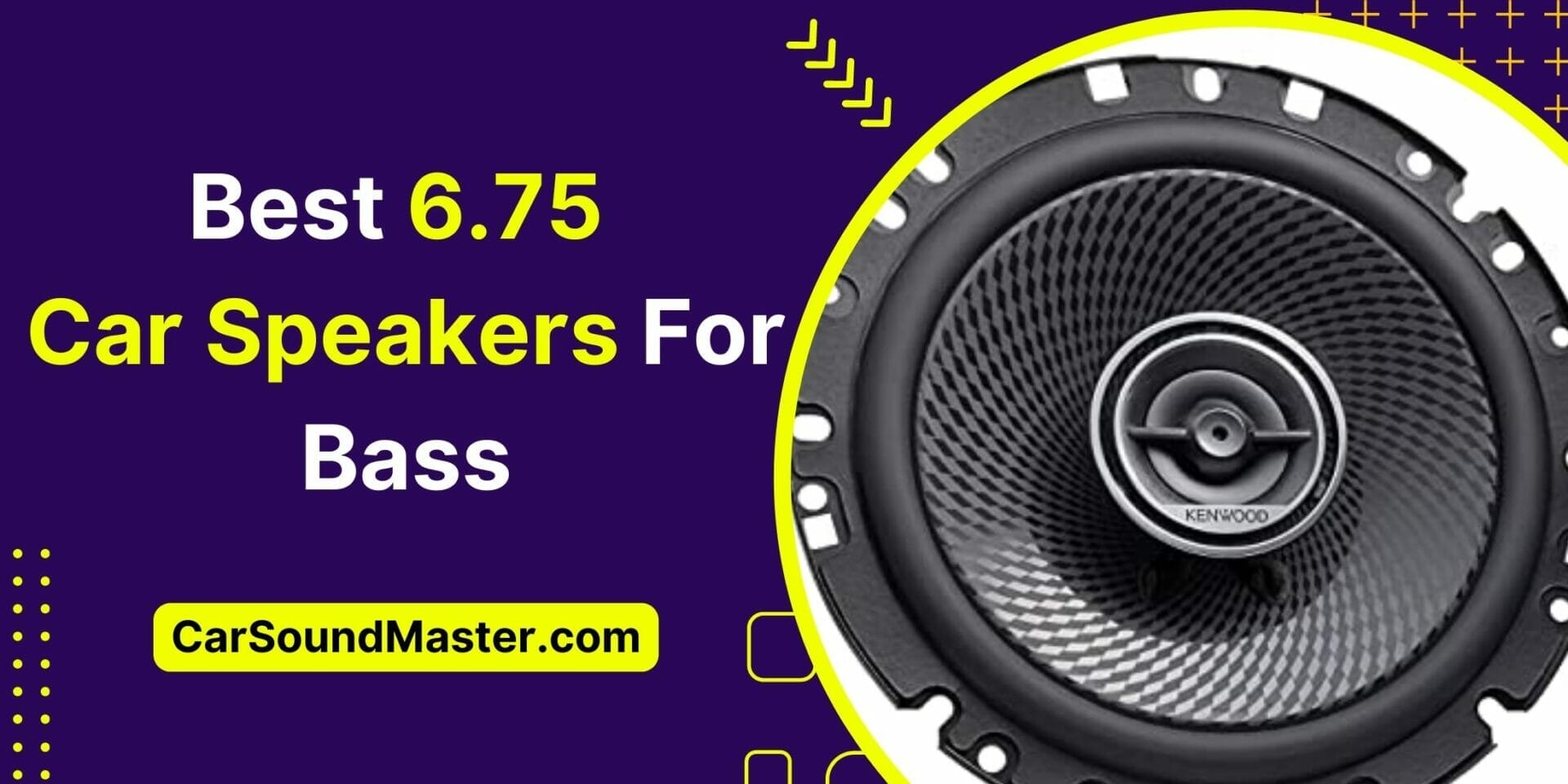6×9 Vs 6.5 Car Speakers – The Ultimate Battle Between Bass and SQ
Because a deep punchy bass is the heart and soul of leisure long drives, I fear anyone would not ever yearn for it. But at the same time, investing in a separate sub may also not be possible for everyone for reasons, maybe like dinky budget or less car space.
That’s when most audiophiles think of a coin toss between the best bass-heavy speakers and the universally prevalent cars’ doors and deck speakers i.e. 6×9 vs 6.5 car speakers.
Choosing between the 6.5 or 6×9 speakers is always one hell of a struggle. The former is a one-sided winner at the loudness and bass-heaviness factors, whereas the latter makes for a contest with its better sound quality, inexpensiveness, lower power ratings, etc.
For that reason, in this article, I’ll evaluate both these speaker types by comparing them in every possible detail. This will help you determine what’s your best bet gonna be.
So start scrolling down.
6×9 Vs 6.5 Car Speakers
The battle between these two speaker sizes has always been a cherished entertainment for most gearhead audiophiles. As for the reasons for that, there are plenty.
Well, before we jump in, let me tell you that 6x9s have some very close siblings too – in 6×8 car speakers. They have an almost imperceptible difference of any kind (in form and function) between them as explained in detail here (6×9 vs 6×8 car speakers).
That’s why the stir caused by the contest between 6×8 and 6.5” speakers in gobs of car stereo enthusiasts is no less than this one. Don’t you believe? Check out this (6×8 vs 6.5 car speakers).
Anyway, let’s get back to the main topic.
While comparing the 6×9 car speakers with their 6.5” counterparts, we’ll be looking at multiple factors including their builds, sound quality, frequency response, power ratings, mounting & installation options, pricing, etc.
#1. Size, Shape, Build Dimensions
The 6×9 Car Speakers
This is one of the biggest car speaker sizes available in the market; perhaps one of the oldest too to go into automobiles. 6x9s come in non-round, side-by-side elongated shapes – the design that would usually favor older cars with limited space for such add-on frills.
They measure around 6.5” in height (approx. 164 mm) and around 9 5/16” (or 235 mm) in width and need a cutout of approx. 145 mm x 230 mm to perfectly sit in. The measurements though are not any deathblow figures and can slightly change from brand to brand.
The 6.5” Car Speakers
6.5s are one of the most popular modern-day speakers that fit almost any vehicle and come stock standards in so many cars as well. These speakers come in perfectly circular shapes off the manufacturing belt and measure at almost the exact stated figures.
#2. Sound Quality and Frequency Range Response
6×9 Speakers
Courtesy of their elongated elliptical construct, 6x9s make for quite a huge surface area at the cone allowing for a bigger amount of air to move. This ultimately translates into significantly louder as well as bass-heavy music.
Though these speakers easily win at the SPL benchmark, they do quite ordinary at SQ standards. The asymmetrical shape of these speakers doesn’t allow for a perfectly even wave dispersion, and the speaker body also doesn’t make an even all-around grasp to the cone.
It means that the cone can easily lose its shape esp. during higher volumes, and the sounds are easily manipulated by resonance or free-air frequencies. Thus, you feel quite impure, unstable, and unimpressive sounds out of 6x9s – the sound coloration, they say it.
As for the frequency range response, if in proper enclosures and all the other requirements are also perfectly met, the 6×9 car speakers can easily cover as vast the audible frequency spectrum as around 35Hz to 24KHz. It makes them even edge past a lot of 8” or similar small-sized subs in their bass performance as well.
The 6.5” Speakers
Because the 6.5 car speakers always flaunt round cones, they do considerably well at the SQ benchmark compared to 6x9s. Their shape symmetry means even signals from all around the conus as well as less sound coloration due to the plumb grip of the body over the cone sheath from each millimeter.
The cone shape has no distortions whatsoever, and the sounds you get out of 6.5s are much crisp, clear, and definite than the typical 6x9s. The cone though is round and smaller in size too, so there is less room for air to move which means that these speakers have a bit limited frequency range response – somewhere around 45Hz to 20KHz.
However, because 6.5s are primarily meant to cover only the mid-range of frequencies, you should ideally be OK with their slightly quieter and less bassy results.
#3. Power, Resistance, Sensitivity Ratings
The 6×9 Speakers
For a good set of 6×9 car speakers, expect the RMS ratings to read anywhere around 135, or 140 watts to up to 250 watts, maybe. Whereas, the peak power rating of a decent 6×9 might be approx. 350 watts or over – well, power ratings vary for coaxials and components, and depend on manufacturers and models too.
You may, not necessarily though, most of the time need to get a powerful amp to make them run at full throttle.
The resistance (also called impedance) is usually rated at 4 Ohms for almost all automobile speakers no matter size, etc. And the sensitivity, well, that varies with the quality of the gimmick. Nonetheless for a good 6×9” speaker, you should ideally expect its sensitivity to be touching or over 90 dB (1W/1mm).
The 6.5 Car Speaker
Smaller and more common sizes like these have quite belted power and related specs. Any standard 6.5 speaker might very well read around 50 watts to 100 watts for RMS and approx. 150 watts to over or around 300 watts for peak power. Again, that depends on the build type, etc.
The speaker sensitivity also depends on multiple factors but you can expect a good 6.5” speaker to stroll around 89 to 92, 93 dB.
#4. Build Types, Options, and Mounting/Installation Patterns
The 6x9s
These speakers usually come in coaxial (also called full-range) builds of both 2-way and 3-way types. The former of the two types consists of a woofer and a tweeter, whereas the latter also introduces a mid-bass driver in addition to the previous two.
Because coaxial speakers don’t allow for as such custom mountings, the coaxial 6x9s (due to their big sizes) are usually difficult to fit into smaller spaces like doors, etc., unless some drawn-out DIYs are done to somehow make a fit. So they usually go onto the car’s rear deck and that’s, in fact, the best place for them too given their excellent bass.
On the contrary, the 6×9 components can help much with that. You can somehow make a way for different drivers to be installed in different places as per your viewpoint of good sound imaging.
Remember though, installing components is always a bit complicated compared to solo-assembly coaxials due to separate drivers, crossovers, and heavy wiring circuitry.
The 6.5” Speakers
6.5s also come in 2-way and 3-way coaxial and components both. Courtesy of their optimally compact and symmetrical builds, smaller speakers like these are usually best fitted for car doors or even dash but can go anywhere you want them to.
Due to their circular shapes and higher SQ levels, people usually prefer going with 6.5” components custom-mounting them in their car’s doors for a quality surround-sound listening experience. However, they can also go into the dashboard or rear deck – wherever you deem perfect.
#5. Pricing, Availability, and Compatibility
The 6×9 Car Speakers
Priced at relatively higher bucks, and for so many good reasons, 6x9s are always the first-line contenders for bigger cars like trucks, SUVs, etc. They are not as commonly available as the 6.5 speakers, however, they still have options for almost every price point depending on brand names and product quality, of course.
The 6×9 car speakers are also a great choice for recreational vehicles, boats, etc. Plus, they can also be placed in smaller DIY retrofit enclosures so they are a good go-to option for cars with no speaker openings – just in case.
The 6.5 Car Speakers
Being a much more universal speaker size for most vehicles, the 6.5” speakers have some real competition in the market. Thus these speakers are not only universally prevalent but also gettable for almost nothing compared to their 6×9 counterparts.
Wrap Up
I guess I’ve had more than enough on the battle of 6×9 vs 6.5 car speakers. You’ve learned almost everything including what are the most basic yet highly significant factors you should check on while getting speakers for your car as well as how the two prominent car speaker sizes in the market perform in all those areas.
To conclude, I’ll again repeat the crux which is: if you are fond of bass-heavy music but can’t invest in a separate subwoofer (due to whatever reason), go with the 6×9 speakers for your car.
On the other hand, if you’re just looking for a simple drop-in replacement of your OEM stocks and also prefer quality in each sound note over extra highs or lows, the 6.5 is the ideal bet you should ever play.







